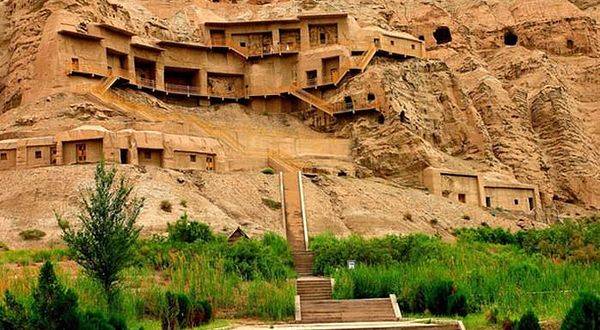Kuqa Grand Canyon National Geopark
Crossing the mountainous section, approaching Kuqa Grand Canyon, this is the last highlight of the southern section of the Duku Highway. Kuqa Grand Canyon is also known as the 'Mysterious Grand Canyon' of Tianshan, called 'Keziliya' in Uyghur, meaning red cliffs. Walking along the narrow valley bottom, you are flanked by towering ochre mudstone mountains that reach the sky, with folds and fractures creating a spectacular landscape, making it a natural geological park.
Yanshuigou Fort Ruins, located about 20 kilometers before entering Kuqa County, pass through Yanshuigou. This is a dried riverbed that crosses the Qiertag Mountains, and along the way, several fort ruins built during the Han and Tang dynasties can be seen.
Kizil Gaha Beacon Tower Ruins
To the south lies the Kizil Gaha Beacon Tower Ruins, a majestic ancient beacon tower standing tall in the wilderness, evoking a sense of awe.
Kuqa Old Town
Kuqa Old Town is concentrated west of the Tuanjie Bridge, at the westernmost end of the city. The core area of the old town consists of Resitan Road and its surrounding streets and alleys. The Kuqa Royal Palace, Kuqa Grand Mosque, and Kehe Dun Beacon Tower are all located here. The buildings here feature colorful old walls and courtyard gates, with a fairy-tale-like dreamy color scheme, yet they also show signs of weathering and age. Each house has a similar decorative style but with endless variations, embodying the essence of Southern Xinjiang. If time permits, consider driving to nearby Buddhist sites for a visit.
The Kizil Caves, also known as the Kizil Thousand-Buddha Caves or the Qizil Caves, are Buddhist rock-cut caves in China. They are located on the cliffs of the Mingwutage Mountains, 7 kilometers southeast of Kizil Town in Baicheng County, Xinjiang. To the south lies the Muzat River Valley. The Kizil Caves are the earliest and westernmost large-scale cave complex in China, with excavation starting around the 3rd century AD and gradually ceasing in the 8th-9th centuries AD. The duration of their construction is unparalleled in the world.
Subashi Buddhist Temple Ruins
Built during the Wei and Jin dynasties, the Subashi Buddhist Temple Ruins were once the royal temple of Kucha. It was as large as a small city, but now only broken walls and ruins remain.















